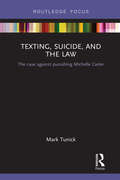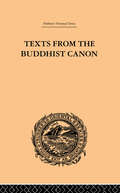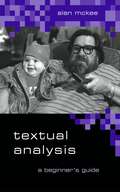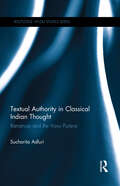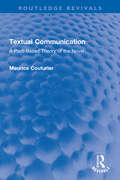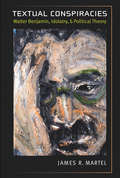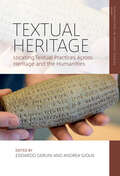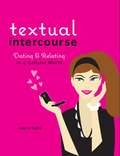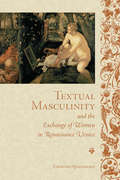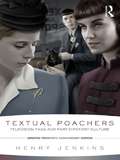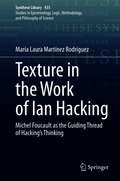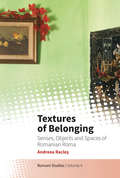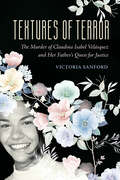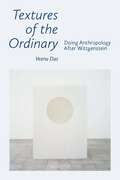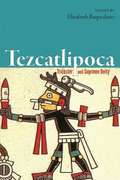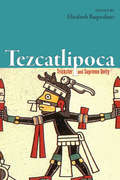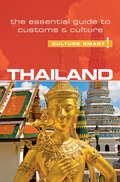- Table View
- List View
Textile Traditions of Mesoamerica and the Andes: An Anthology
by Janet Catherine Berlo Margot Blum Schevill Edward B. DwyerIn this volume, anthropologists, art historians, fiber artists, and technologists come together to explore the meanings, uses, and fabrication of textiles in Mexico, Guatemala, Ecuador, Peru, and Bolivia from Precolumbian times to the present. Originally published in 1991 by Garland Publishing, the book grew out of a 1987 symposium held in conjunction with the exhibit "Costume as Communication: Ethnographic Costumes and Textiles from Middle America and the Central Andes of South America" at the Haffenreffer Museum of Anthropology, Brown University.
Texting, Suicide, and the Law: The case against punishing Michelle Carter
by Mark TunickIn 2014, Conrad Roy committed suicide following encouragement from his long-distance girlfriend, Michelle Carter, in what has become known as the Texting Suicide case. The case has attracted much attention, largely focusing on the First Amendment free speech issue. This book takes the view that the issue is intertwined with several others, some of which have received less attention but help explain why the case is so captivating and important, issues concerning privacy, accountability, coercion, punishment, and assisted suicide. The focus here is on how all of these issues are interconnected. By breaking the issue down into its complex layers, the work aids reasoned judgment, ensuring we aren’t guided solely by our gut reactions. The book is laid out as a case against punishing Ms. Carter, but it is less important that we agree with that conclusion than that we reach our conclusions not just through our instincts and intuitions but by thinking about these fundamental issues. The work will be of interest to scholars in law, political theory, and philosophy as an example of how theoretical issues apply to particular controversies. It will also appeal to readers interested in freedom of speech and the First Amendment, criminal justice and theories of punishment, suicide laws, and privacy.
Texts from the Buddhist Canon: Commonly Known as Dhammapada
by Samuel BealFirst Published in 2000. Routledge is an imprint of Taylor & Francis, an informa company.
Texts, Traditions, and Sacredness: Cultural Translation in Kristapurāṇa
by Annie Rachel RoysonThis book presents a critical reading of Kristapurāṇa, the first South Asian retelling of the Bible. In 1579, Thomas Stephens (1549–1619), a young Jesuit priest, arrived in Goa with the aim of preaching Christianity to the local subjects of the Portuguese colony. Kristapurāṇa (1616), a sweeping narrative with 10,962 verses, is his epic poetic retelling of the Christian Bible in the Marathi language. This fascinating text, which first appeared in Roman script, is also one of the earliest printed works in the subcontinent. Kristapurāṇa translated the entire biblical narrative into Marathi a century before Bible translation into South Asian languages began in earnest in Protestant missions. This book contributes to an understanding of translation as it was practiced in South Asia through its study of genre, landscapes, and cultural translation in Kristapurāṇa, while also retelling a history of sacred texts and biblical narratives in the region. It examines this understudied masterpiece of Christian writing from Goa in the early era of Catholic missions and examines themes such as the complexities of the colonial machinery, religious encounters, textual traditions, and multilingualism, providing insight into Portuguese Goa of the sixteenth and seventeenth centuries. The first of its kind, the book makes significant interventions into the current discourse on cultural translation and brings to the fore a hitherto understudied text. It will be an indispensable resource for students and researchers of translation studies, comparative literature, religious studies, biblical studies, English literature, cultural studies, literary history, postcolonial studies, and South Asian studies.
Textual Analysis: A Beginner's Guide
by Dr Alan Mckee`Alan McKee presents a student friendly introduction to the analysis of cultural texts. The book highlights the cultural differences in interpretation with an array of fascinating examples. Textual Analysis is written in an accessible style with several useful case studies. Each chapter also includes exercises for classroom' - Jane Stokes, London Metropolitan University `McKee is a gifted practitioner of the skills he would teach in this book, as well as a lively and engaging writer and one who has a real commitment to making his ideas available to a larger public' - Henry Jenkins, Massachusetts Institute of Technology This book provides an indispensable basic introduction to textual analysis. McKee starts from the most basic philosophical foundations that underlie the practice and explains why texts are important and what they tell us about the world they represent. Textual Analysis guides students away from finding the `correct' interpretation of a text and explains why we can't simply ask audiences about the interpretations they make of texts. Textual Analysis: - points to the importance of context, genre and modality - uses excellent examples drawn from popular culture - provides students with a solid grounding on many of the important concepts underlying media and cultural studies Written in an accessible and straightforward style Textual Analysis: A Beginners Guide will be essential reading for all students of media, cultural and communication studies.
Textual Authority in Classical Indian Thought: Ramanuja and the Vishnu Purana (Routledge Hindu Studies Series)
by Sucharita AdluriTheistic Vedānta originated with Rāmānuja (1077-1157), who was one of the foremost theologians of Viśistādvaita Vedānta and also an initiate of the Śrīvaisnava sectarian tradition in South India. As devotees of the God Visnu and his consort Śrī, the Śrīvaisnavas established themselves through various processes of legitimation as a powerful sectarian tradition. One of the processes by which the authority of the Śrīvaisnavas was consolidated was Rāmānuja’s synthesis of popular Hindu devotionalism with the philosophy of Vedānta. This book demonstrates that by incorporating a text often thought to be of secondary importance - the Visnu Purāna (1st-4th CE) - into his reading of the Upanisads, which were the standard of orthodoxy for Vedānta philosophy, Rāmānuja was able to interpret Vedānta within the theistic context of Śrīvaisnavism. Rāmānuja was the first Brahmin thinker to incorporate devotional purānas into Vedānta philosophy. His synthetic theology called Viśistādvaita (unity-of-the-differenced) wielded tremendous influence over the expansion of Visnu devotionalism in South India and beyond. In this book, the exploration of the exegetical function of this purana in arguments salient to Rāmānuja’s Vedānta facilitates our understanding of the processes of textual accommodation and reformulation that allow the incorporation of divergent doctrinal claims. Expanding on and reassessing current views on Rāmānuja’s theology, the book contributes new insights to broader issues in religious studies such as canon expansion, commentarial interpretation, tradition-building, and the comparative study of scripture. It will be of interest to students and scholars of Indian philosophy and Religious Studies.
Textual Communication: A Print-Based Theory of the Novel (Routledge Revivals)
by Maurice CouturierFirst published in 1991, Textual Communication examines the character and development of the novel from Richardson to Nabokov in relation to the printing and publishing industry. The book blends literary theory with a historical analysis of communication, carrying the debate on the novel beyond the pioneering work of Booth and Genette, while responding to and taking issue with the writings of Foucault, Baudrillard, McLuhan, and Barthes. It analyses the structures of the industry which manufactured and marketed novels to show how novelists solved the communication problems that they faced in the eighteenth, nineteenth, and twentieth centuries. It also pinpoints critical moments in the history of the novel when new narrative strategies appeared, and places them in the context of the communication environment in which the texts were produced. Using Lacan’s theory of the divided subject, the book defines textual communication as a form of interaction in which two divided subjects, the author and the reader, try to communicate with each other under or against the law of the book market, censorship, literary conventions, and language.
Textual Conspiracies: Walter Benjamin, Idolatry, and Political Theory
by Martel James R.Engaging political and literary luminaries in an alternative narrative about power
Textual Heritage: Locating Textual Practices Across Heritage and the Humanities (Explorations in Heritage Studies)
by Edoardo Gerlini Andrea GiolaiThe relationship between texts and the field of cultural heritage remains ill-defined. Although scholarship has long recognized the importance of textual practices in mediating cultural identity and memory, the emphasis heritage studies places on authentic, material traces downplays the unique impact of their creative transmission and appropriation. Focusing on the afterlives of written artifacts and the re-use of their textual contents, primarily within East Asia, Textual Heritage highlights how textual practices offer a lens for understanding questions of canonization, embodiment, and circulation. Through case studies ranging from Japanese court music to digital editions, this volume advances a theory of “humanistic heritage studies” that better understands the overlap between literary and heritage studies.
Textual Intercourse
by Laura SabaForget instant messaging and e-mail?we are undergoing a text message revolution Text messaging is the newest and preferred wave of communication for the younger demographic and the number one application of cell phones. The market is ripe for this relationship guide for texters With this new trend come all kinds of questions and confusion concerning textual communication and protocol within relationships girls never would have imagined a generation ago. Tantalizing topics include: ? The dos and donOCOts of texting your significant other? Interpreting exactly what his text messages mean? Finding the right balance between texting and in-person communication? The ins and outs of building textual confidence? The art of textual flirtation? And so much more This revealing and useful book demonstrates exactly how those tiny text messages you send today can create big success for your love life tomorrow. "
Textual Masculinity and the Exchange of Women in Renaissance Venice
by Courtney QuaintanceTextual Masculinity and the Exchange of Women in Renaissance Venice is a provocative analysis of the pornographic poetry written in patrician poet Domenico Venier's social circle. While Venier and his salon were renowned for elegant love sonnets featuring unattainable female beloveds, among themselves they wrote and circulated poems in Venetian dialect in which women were prostitutes whose defiled bodies were available to all.Courtney Quaintance analyses poetry, letters, plays, and verse dialogues to show how male writers established, sustained, and publicized their relationships to one another through the exchange of fictional women. She also shows how Gaspara Stampa and Veronica Franco, two women writers with ties to the salon, appropriated and transformed tropes of female sexuality and male literary collaboration to position themselves within this homosocial literary economy. Based on archival work and Quaintance's exceptional knowledge of Venetian dialect poetry, Textual Masculinity and the Exchange of Women in Renaissance Venice is an unprecedented window into the understudied world of Venetian literature.
Textual Poachers: Television Fans and Participatory Culture
by Henry JenkinsThe culture of fanfiction.
Textual Poachers: Television Fans and Participatory Culture
by Henry JenkinsThe twentieth anniversary edition of Henry Jenkins’s Textual Poachers brings this now-canonical text to a new generation of students interested in the intersections of fandom, participatory culture, popular consumption and media theory. Supplementing the original, classic text is an interview between Henry Jenkins and Suzanne Scott in which Jenkins reflects upon changes in the field since the original release of Textual Poachers. A study guide by Louisa Stein helps provides instructors with suggestions for the way Textual Poachers can be used in the contemporary classroom, and study questions encourage students to consider fan cultures in relation to consumer capitalism, genre, gender, sexuality, and more.
Textual Relations in the Qur'an: Relevance, Coherence and Structure (Routledge Studies in the Qur'an)
by Salwa M. El-AwaRepresenting a new development in the study of Qur'anic text, this book tackles the issue of Qur'anic text structure by fusing the fields of linguistics and Qur'anic studies. The Qur'an contains many long suras covering diverse topics but with no apparent common context within which such variety can be explained. This book proposes a new explanation of Qur'anic text structure, arguing that the long suras have structure that are explicable within a framework for the mechanisms of human verbal communication. Through a systematic step-by-step analysis of the cognitive process involved in verbal communication and comprehension of text, this work provides interesting and useful insights into methods of analysis, mechanisms and dynamics of the Qur'anic text structure. The unique application of a sophisticated linguistic theory to the Qur'an introduces an entirely new way of reading the Qur'an and with detailed analysis of two Qur'anic passages the book presents a solid working out of the theory that will be accessible to both linguists and scholars of the Qur'an.
Textual Travels: Theory and Practice of Translation in India
by Mini Chandran Suchitra MathurThis book presents a comprehensive account of the theory and practice of translation in India in combining both its functional and literary aspects. It explores how the cultural politics of globalization is played out most powerfully in the realm of popular culture, and especially the role of translation in its practical facets, ranging from the fields of literature and publishing to media and sports.
Texture in the Work of Ian Hacking: Michel Foucault as the Guiding Thread of Hacking’s Thinking (Synthese Library #435)
by María Laura Martínez RodríguezThis book offers a systematized overview of Ian Hacking's work. It presents Hacking’s oeuvre as a network made up of four interconnected key nodes: styles of scientific thinking & doing, probability, making up people, and experimentation and scientific realism.Its central claim is that Michel Foucault’s influence is the underlying thread that runs across the Canadian philosopher’s oeuvre. Foucault’s imprint on Hacking’s work is usually mentioned in relation to styles of scientific reasoning and the human sciences. This research shows that Foucault’s influence can in fact be extended beyond these fields, insofar the underlying interest to the whole corpus of Hacking’s works, namely the analysis of conditions of possibility, is stimulated by the work of the French philosopher.Displacing scientific realism as the central focus of Ian Hacking’s oeuvre opens up a very different landscape, showing, behind the apparent dispersion of his works, the far-reaching interest that amalgamates them: to reveal the historical and situated conditions of possibility for the emergence of scientific objects and concepts.This book shows how Hacking’s deployment concepts such as looping effect, making up people, and interactive kinds, can complement Foucauldian analyses, offering an overarching perspective that can provide a better explanation of the objects of the human sciences and their behaviors.
Texture: Human Expression in the Age of Communications Overload (The\mit Press Ser.)
by Richard H. HarperWhy we complain about communication overload even as we seek new ways to communicate.Our workdays are so filled with emails, instant messaging, and RSS feeds that we complain that there's not enough time to get our actual work done. At home, we are besieged by telephone calls on landlines and cell phones, the beeps that signal text messages, and work emails on our BlackBerrys. It's too much, we cry (or type) as we update our Facebook pages, compose a blog post, or check to see what Shaquille O'Neal has to say on Twitter. In Texture, Richard Harper asks why we seek out new ways of communicating even as we complain about communication overload.Harper describes the mistaken assumptions of developers that “more” is always better and argues that users prefer simpler technologies that allow them to create social bonds. Communication is not just the exchange of information. There is a texture to our communicative practices, manifest in the different means we choose to communicate (quick or slow, permanent or ephemeral).
Textures of Belonging: Senses, Objects and Spaces of Romanian Roma (Romani Studies #4)
by Andreea RacleșThe longstanding European conception that Roma and non-Roma are separated by unambiguous socio-cultural distinctions has led to the construction of Roma as “non-belonging others.” Challenging this conception, Textures of Belonging explores how Roma negotiate and feel belonging at the everyday level. Inspired by material culture, sensorial anthropology, and human geography approaches, this book uses ethnographic research to examine the role of domestic material forms and their sensorial qualities in nurturing connections with people and places that transcend socio-political boundaries.
Textures of Terror: The Murder of Claudina Isabel Velasquez and Her Father's Quest for Justice (California Series in Public Anthropology #55)
by Victoria SanfordInvestigating the unsolved murder of a female law student and the pervasive violence against Guatemalan women that drives migration. Part memoir and part forensic investigation, Textures of Terror is a gripping first-person story of women, violence, and migration out of Guatemala—and how the United States is implicated. Accompanying Jorge Velásquez in a years-long search for answers after the brutal murder of his daughter Claudina Isabel, Victoria Sanford explores what it means to seek justice in "postconflict" countries where violence never ended. Through this father's determined struggle and other stories of justice denied, Textures of Terror offers a deeper understanding of US policies in Latin America and their ripple effect on migration. Sanford offers an up-close appraisal of the inner workings of the Guatemalan criminal justice system and how it maintains inequality, patriarchy, and impunity. Presenting the stories of other women who have suffered at the hands of strangers, intimate partners, and the security forces, this work reveals the deeply gendered nature of power and violence in Guatemala.
Textures of the Ordinary: Doing Anthropology after Wittgenstein (Thinking from Elsewhere)
by Veena DasHow might we speak of human life amid violence, deprivation, or disease so intrusive as to put the idea of the human into question? How can scholarship and advocacy address new forms of war or the slow, corrosive violence that belie democracy's promise to mitigate human suffering? To Veena Das, the answers to these question lie not in foundational ideas about human nature but in a close attention to the diverse ways in which the natural and the social mutually absorb each other on a daily basis. Textures of the Ordinary shows how anthropology finds a companionship with philosophy in the exploration of everyday life. Based on two decades of ethnographic work among low-income urban families in India, Das shows how the notion of texture aligns ethnography with the anthropological tone in Wittgenstein and Cavell, as well as in literary texts. Das shows that doing anthropology after Wittgenstein does not consist in taking over a new set of terms such as forms of life, language games, or private language from Wittgenstein’s philosophy. Instead, we must learn to see what eludes us in the everyday precisely because it is before our eyes. The book shows different routes of return to the everyday as it is corroded not only by catastrophic events but also by repetitive and routine violence within everyday life itself. As an alternative to normative ethics, this book develops ordinary ethics as attentiveness to the other and as the ability of small acts of care to stand up to horrific violence.Textures of the Ordinary offers a model of thinking in which concepts and experience are shown to be mutually vulnerable. With questions returned to repeatedly throughout the text and over a lifetime, this book is an intellectually intimate invitation into the ordinary, that which is most simple yet most difficult to perceive in our lives.
Tezcatlipoca
by Elizabeth BaquedanoTezcatlipoca: Trickster and Supreme Deity brings archaeological evidence into the body of scholarship on "the lord of the smoking mirror," one of the most important Aztec deities. While iconographic and textual resources from sixteenth-century chroniclers and codices have contributed greatly to the understanding of Aztec religious beliefs and practices, contributors to this volume demonstrate the diverse ways material evidence expands on these traditional sources.The interlocking complexities of Tezcatlipoca's nature, multiple roles, and metaphorical attributes illustrate the extent to which his influence penetrated Aztec belief and social action across all levels of late Postclassic central Mexican culture. Tezcatlipoca examines the results of archaeological investigations--objects like obsidian mirrors, gold, bells, public stone monuments, and even a mosaic skull--and reveals new insights into the supreme deity of the Aztec pantheon and his role in Aztec culture.
Tezcatlipoca: Trickster and Supreme Deity (G - Reference, Information And Interdisciplinary Subjects Ser.)
by Elizabeth BaquedanoTezcatlipoca: Trickster and Supreme Deity brings archaeological evidence into the body of scholarship on “the lord of the smoking mirror,” one of the most important Aztec deities. While iconographic and textual resources from sixteenth-century chroniclers and codices have contributed greatly to the understanding of Aztec religious beliefs and practices, contributors to this volume demonstrate the diverse ways material evidence expands on these traditional sources. The interlocking complexities of Tezcatlipoca’s nature, multiple roles, and metaphorical attributes illustrate the extent to which his influence penetrated Aztec belief and social action across all levels of late Postclassic central Mexican culture. Tezcatlipoca examines the results of archaeological investigations—objects like obsidian mirrors, gold, bells, public stone monuments, and even a mosaic skull—and reveals new insights into the supreme deity of the Aztec pantheon and his role in Aztec culture.
Thai Stick: Surfers, Scammers, and the Untold Story of the Marijuana Trade
by Peter MaguireLocated on the left bank of the Chao Phya River, Thailand's capital, Krungthep, known as Bangkok to Westerners and "the City of Angels" to Thais, has been home to smugglers and adventurers since the late eighteenth century. During the 1970s, it became a modern Casablanca to a new generation of treasure seekers, from surfers looking to finance their endless summers to wide-eyed hippie true believers and lethal marauders left over from the Vietnam War. Moving a shipment of Thai sticks from northeast Thailand farms to American consumers meant navigating one of the most complex smuggling channels in the history of the drug trade. Many forget that until the mid-1970s, the vast majority of marijuana consumed in the United States was imported, and there was little to no domestic production.Peter Maguire and Mike Ritter are the first historians to document this underground industry, the only record of its existence rooted in the fading memories of its elusive participants. Drawing on hundreds of interviews with smugglers and law enforcement agents, the authors recount the buy, delivery, voyage home, and product offload. They capture the eccentric personalities of the men and women who transformed the Thai marijuana trade from a GI cottage industry into a professionalized business moving the world's most lucrative commodities, unraveling a rare history from the smugglers' perspective.
Thai Ways
by Denis SegallerWritten by an Englishman who has spent most of his adult years in Thailand, the pieces in this collection were originally published as columns in Thailand's English-language newspaper. Topics include language, food, festivals, worship, the calendar, and "do's and don'ts" for visitors. This book will be of value to anyone planning a trip to Thailand or anyone who wishes to learn more about the country.
Thailand - Culture Smart!
by Roger JonesCulture Smart! provides essential information on attitudes, beliefs and behavior in different countries, ensuring that you arrive at your destination aware of basic manners, common courtesies, and sensitive issues. These concise guides tell you what to expect, how to behave, and how to establish a rapport with your hosts. This inside knowledge will enable you to steer clear of embarrassing gaffes and mistakes, feel confident in unfamiliar situations, and develop trust, friendships, and successful business relationships. Culture Smart! offers illuminating insights into the culture and society of a particular country. It will help you to turn your visit-whether on business or for pleasure-into a memorable and enriching experience. Contents include * customs, values, and traditions * historical, religious, and political background * life at home * leisure, social, and cultural life * eating and drinking * do's, don'ts, and taboos * business practices * communication, spoken and unspoken "Culture Smart has come to the rescue of hapless travellers." Sunday Times Travel "... the perfect introduction to the weird, wonderful and downright odd quirks and customs of various countries." Global Travel "...full of fascinating-as well as common-sense-tips to help you avoid embarrassing faux pas." Observer "...as useful as they are entertaining." Easyjet Magazine "...offer glimpses into the psyche of a faraway world." New York Times From the Trade Paperback edition.

